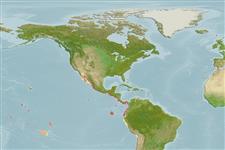>
Carangiformes (Jacks) >
Carangidae (Jacks and pompanos) > Trachinotinae
Etymology: Trachinotus: Greek, trachys, -eia, -ys = rough + Greek,noton = back (Ref. 45335).
Eponymy: C W Kennedy was Lieutenant Commander on the Hassler Expedition (1871–1872) from Boston to San Francisco via the Straits of Magellan. [...] (Ref. 128868), visit book page.
More on author: Steindachner.
Environment: milieu / climate zone / depth range / distribution range
экология
морской; солоноватоводный демерсальный. Tropical; 33°N - 20°S
Eastern Pacific: Bahía Magdalena, Baja California Sur, Mexico and southern Gulf of California to Ecuador.
Size / Вес / Возраст
Maturity: Lm ? range ? - ? cm
Max length : 90.0 cm TL самец/пол неопределен; (Ref. 55763); common length : 40.0 cm TL самец/пол неопределен; (Ref. 55763)
Краткое описание
определительные ключи | морфология | морфометрия
Body short, deep, and compressed; mouth small; teeth small, villiform, and only slightly hooked, didsappearing with age; lower branch of first gill arch with 9 to 12 gill rakers; dorsal fin with 6 spines followed by another spine and 17 to 19 soft rays (VII+I,17-19); nape prominent in adults; upper third of head and body dark; belly silvery; a dark axillary stain I covered by the pectoral fin (Ref. 55763).
Adults occur in coastal waters (Ref. 9283). They are common in shallow water and feed mainly on mollusks, but also take crustaceans and small fishes (Ref. 9283). Juveniles are frequently encountered in estuaries and feed on a variety of benthic invertebrates (Ref. 9283). Marketed fresh and salted or dried (Ref. 9283).
Life cycle and mating behavior
половая зрелость | размножение | нерест | икра | Fecundity | личинки
Smith-Vaniz, W.F., 1995. Carangidae. Jureles, pámpanos, cojinúas, zapateros, cocineros, casabes, macarelas, chicharros, jorobados, medregales, pez pilota. p. 940-986. In W. Fischer, F. Krupp, W. Schneider, C. Sommer, K.E. Carpenter and V. Niem (eds.) Guia FAO para Identification de Especies para lo Fines de la Pesca. Pacifico Centro-Oriental. 3 Vols. FAO, Rome. (Ref. 9283)
Статус Красного Списка МСОП (Ref. 130435: Version 2024-1)
Угроза для людей
Harmless
Использование человеком
рыболовство: не имеет хозяйственного значения; объект спортивного рыболовства: да
дополнительная информация
инструменты
Специальные отчеты
Скачать в формате XML
ресурсы в Интернет
Estimates based on models
Preferred temperature (Ref.
123201): 20.8 - 28.5, mean 25.9 °C (based on 60 cells).
Phylogenetic diversity index (Ref.
82804): PD
50 = 0.5000 [Uniqueness, from 0.5 = low to 2.0 = high].
Bayesian length-weight: a=0.01445 (0.00779 - 0.02682), b=2.93 (2.76 - 3.10), in cm total length, based on LWR estimates for this species & (Sub)family-body (Ref.
93245).
Trophic level (Ref.
69278): 3.8 ±0.55 se; based on food items.
устойчивость к внешним воздействиям (Ref.
120179): средний (среднего размера), минимальное время удвоения популяции 1.4-4.4 года (Preliminary K or Fecundity.).
Fishing Vulnerability (Ref.
59153): High vulnerability (56 of 100).
